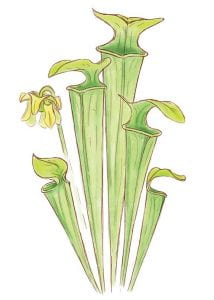
S. oreophila sketch [1]
Congratulations! We have made it through half of the species of
Sarracenia! Unfortunately, we will have to wait until the next two entries to talk about some of the more interesting North American pitcher plants, but
S. oreophila is by no means boring. The green pitcher plant is very similar to
S. flava, and somewhat resembles
S. alata and
S. rubra. This plant has two very interesting aspects: its conservation status and its phyllodia. Before getting to the exciting stuff, however, we will talk about the general characteristics of this plant.

S. oreophila range distribution [2]
This plant is found in small hilly areas in Alabama, Tennessee, North Carolina, and Georgia. Unlike most
Sarracenia, it is found in isolated mainland stands rather than coastal plains. The plant is mostly green, hence the name, and features a yellow flower. The plant features multiple erect pitcher tubes, a common characteristic of most
Sarracenia. These pitchers generally grow up to two feet tall, and look fairly similar to the pitchers of
S. flava. In fact, at one point, it was just considered to be a variety of
S. flava. One interesting feature about this plant is that its pitchers grow very rapidly in the early spring, but die off well before fall even begins. This makes the plant unpopular among horticulturists, mainly because it doesn’t have living pitchers for very long.
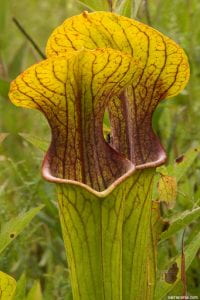
S. oreophila; note the similar general shape as S. flava [3]
Sadly, this plant is critically endangered in the wild, and is only found in a few isolated stands. The plant lost most of its wild population due to urbanization and habitat destruction, but it is at little risk of further habitat destruction. The few remaining
S. oreophila sites are protected by federal, state, and nonprofit organizations, so there is not a large threat of habitat loss for this species. This
does not mean this plant is safe. In fact, it is quite the opposite. Due to changing water tables and other more complicated factors such as poaching, this plant is likely to become extinct in the wild in the next few decades.
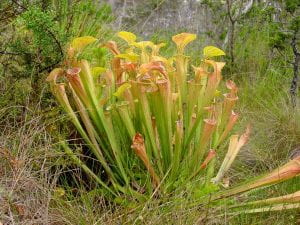
A rare site: a large stand of wild S. oreophila [4]
One interesting characteristic about this plant is that it produces a large amount of non-carnivorous leaves known as phyllodia. These leaves are small, sickle shaped appendages that do not function as a trap. Instead, they require little energy for the plant to produce, so they help the plant maximize photosynthesis and make up for the large amount of energy needed to grow large carnivorous pitchers.
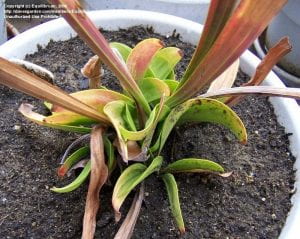
Sickle phyllodia of S. oreophila [5]
S. oreophila var. oreophila – this is the common epithet of the green pitcher plant, and features light, reticulated venation.
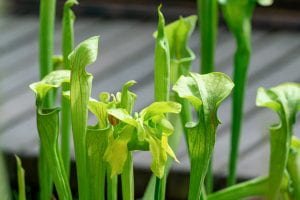
S. oreophila var. oreophila; note the large presence of green color and lack of prominent venation [6]
– this variety is similar to
S. flava var.
ornata in that it features beautiful pinstripe venation, and oftentimes has brilliant purple and red hues diffused in the pitcher lid and mouth.
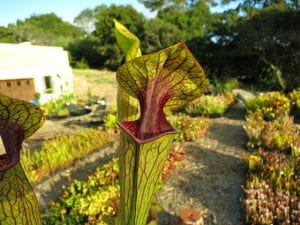
S. oreophila var. ornata; note the striking veining and bright red throat patch [7]
As you can see, despite not being as flashy as
S. leucophylla or as bizarre as
S. psittacina, this is by no means an ugly plant. In fact, I spent $45 just to get this plant. Finding a seller was very difficult, as it is illegal to sell this plant outside state lines due to its conservation status. Luckily, I found a great seller that had a seed grown plant available for sale, so I purchased it without hesitation. Below are pictures of this rarity, showing off its bright green hue.

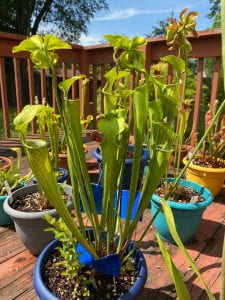
My green pitcher plant showing off its beautiful flowers and pitchers.
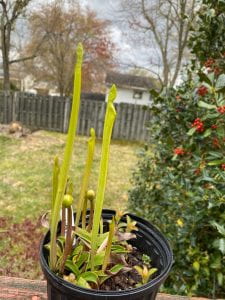
My green pitcher plant early this spring producing its first few pitchers.
- https://lh3.googleusercontent.com/_scBVcY9K0Q9OvDxH9OAg4KP_Fy-5TrXYElAB1tmZ3Hun1UPsoFWFCTrJbEKODAVCoqOnw=s85
- https://upload.wikimedia.org/wikipedia/commons/thumb/1/1c/Sarracenia_oreophila_range.png/220px-Sarracenia_oreophila_range.png
- https://lh3.googleusercontent.com/CCp81vIbBt5Tj63rPeTByfByEosYYQO4hcf1lpB9g0EXAKP9PvClYQS2pLywX2fmAYyA=s85
- https://lh3.googleusercontent.com/iZV7lLtAWMsQpoRUjEX9n9vvo6CMUvp9UHUNJclZNeFjJO7hxX_YJz4wKzTOcIcjB8ommC4=s113
- https://lh3.googleusercontent.com/y6ksOgflPV0ilK7uOQrngOIKtNb3SpAuO0uwOIVp6rer6RVVKqsc-v752ucolbOioeBqnjY=s107
- https://lh3.googleusercontent.com/qJeeXta-A-K5ur6ug1V-CIXh9jiRnTDqNM-62EceMp4w9_6JGnJUChlYH97buO2ybYCnOg=s128
- https://lh3.googleusercontent.com/khEMuYQMztDbhvCwDGBJ8GqMu2A32HaE4WOHuDIDeZvxUzIfHnAzd_uG63wWcdNkRSKn=s113










One of the best parts of your blog is the visuals. The pictures are very helpful and add spice to your topic. I am interested in the size of your plant collection and if you have other things. My father was super into growing and had a variety of very rare plants so your blogs are relatable and easy to read.
I mostly just grow Sarracenia, but I have a few Drosera (sundew) growing alongside my pitcher plants. I will do a blog on sundew in the future, but they basically have sticky leafy tendrils that bugs will stick to. Then the tendrils curl in on the stuck bug and begin releasing digestive enzymes. These plants are very weedy, and have begun somehow taking over every pot in my bog garden. This is not a bad thing, as they are not parasitic, but very interesting to note how rapidly they spread.
I have no idea how you keep all these names straight, I was lost with the names after the first week. Very interesting to hear about the illegality of owning the plant outside of state lines. Glad you were able to get your hands on the plant and share it with us.
I had to read a 1500 page book about these plants for my high school STEM research project… let’s just say I know TOO much about these plants…
It must be cool to have so many plants and also know so much about them. Your insight and knowledge is always easily understood in your blog.